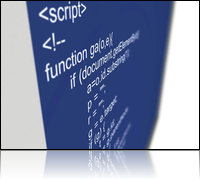Wild Friday Night with Javascript Controllers
- February 20, 2009 10:53 PM
- Javascript
- Comments (4)

Here We Go Again
Ok, so my first attempt will be to convert the final controller object we ended up with in evolution of a js controller scheme and turn it into an object that can be created with the new keyword. I'm using the same HTML as before:
<head>
<title>Test</title>
<script>
...
</script>
</head>
<body>
<button id="button1">I'm a Button</button>
</body>
</html>
Ok, lets start with the basics and go from there. We create a function called Controller, and use it as a constructor to create a new object. Then we'll alert that new object, just so you can be sure that we are doing it right.
function Controller() {
};
var myController = new Controller();
alert(myController);
</script>
First step down. Now lets add in our config object and the ability to pass in a userID through the options.
function Controller(options) {
var config = {
IDs: {
button: 'button1'
}
};
// Private
var options = options;
};
var myController = new Controller({userID: 1234});
alert(myController);
</script>
Now lets add in our private methods getUserID() and handleClick(), and the private variable button.
function Controller(options) {
var config = {
IDs: {
button: 'button1'
}
};
// Private
var options = options;
var button;
// Private Methods
function getUserID() {
return options.userID;
}
function handleClick () {
alert(getUserID());
}
};
var myController = new Controller({userID: 1234});
alert(myController);
</script>
Next up is our public method, setUserID().
function Controller(options) {
var config = {
IDs: {
button: 'button1'
}
};
// Private
var options = options;
var button;
// Private Methods
function getUserID() {
return options.userID;
}
function handleClick () {
alert(getUserID());
}
// Public Methods
this.setUserID = function (userID) {
options.userID = userID;
}
};
var myController = new Controller({userID: 1234});
alert(myController);
</script>
If you'll notice, I assigned this function as a public method using the this keyword to refer to to the resulting object itself. Happy yet Ben? :)
The last step we need is our initialization, and since we need the DOM to do it, we'll have to push the code into a window.onload function. Also, we can ditch alerting the myController object, since we will now be able to test the total result by clicking on "I'm a Button".
function Controller(options) {
var config = {
IDs: {
button: 'button1'
}
};
// Private
var options = options;
var button;
// Private Methods
function getUserID() {
return options.userID;
}
function handleClick () {
alert(getUserID());
}
// Public Methods
this.setUserID = function (userID) {
options.userID = userID;
}
// Constructor
button = document.getElementById(config.IDs.button);
button.onclick = handleClick;
};
window.onload = function () {
var myController = new Controller({userID: 1234});
myController.setUserID(6789);
}
</script>
Ok, so there you go, I used the new keyword, and I even used the this keyword correctly as well.
I'm done right? Can I play Fallout 3 now? :)

Comments
var options = options;
this.options = "test";
... then, in the setUserID() method, I alert options:
alert( options )
... it alerts [object], not the string test.
I guess this is the way that ColdFusion works as well, but have not tested it.
I think CF will respond the same in this situation; the local variable presidence over the this scope, since its relative to the function, not just the whole object.
I suspect you are correct.